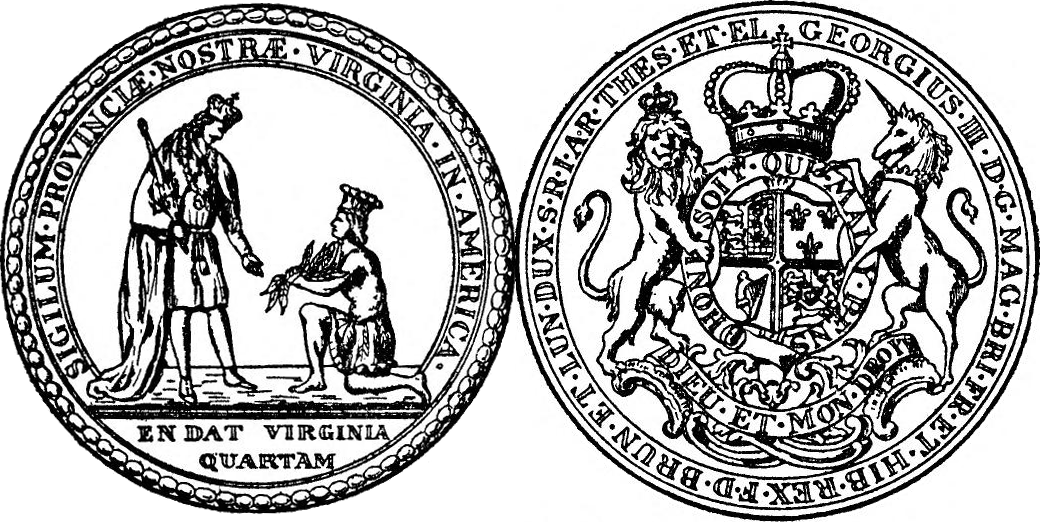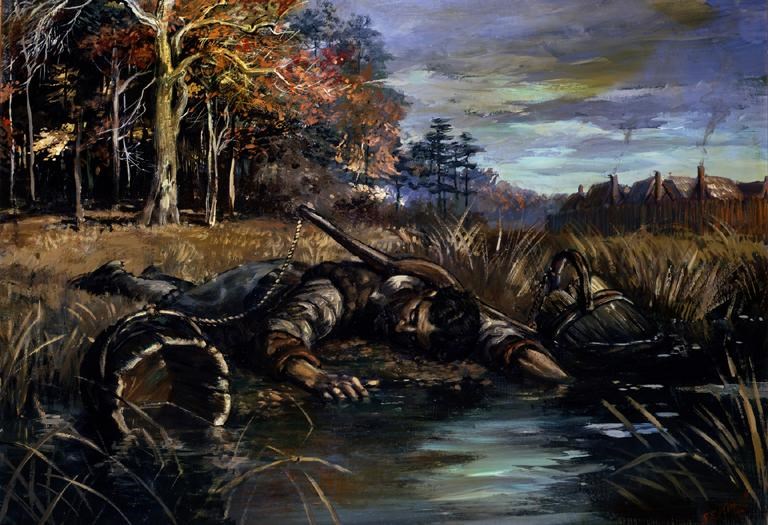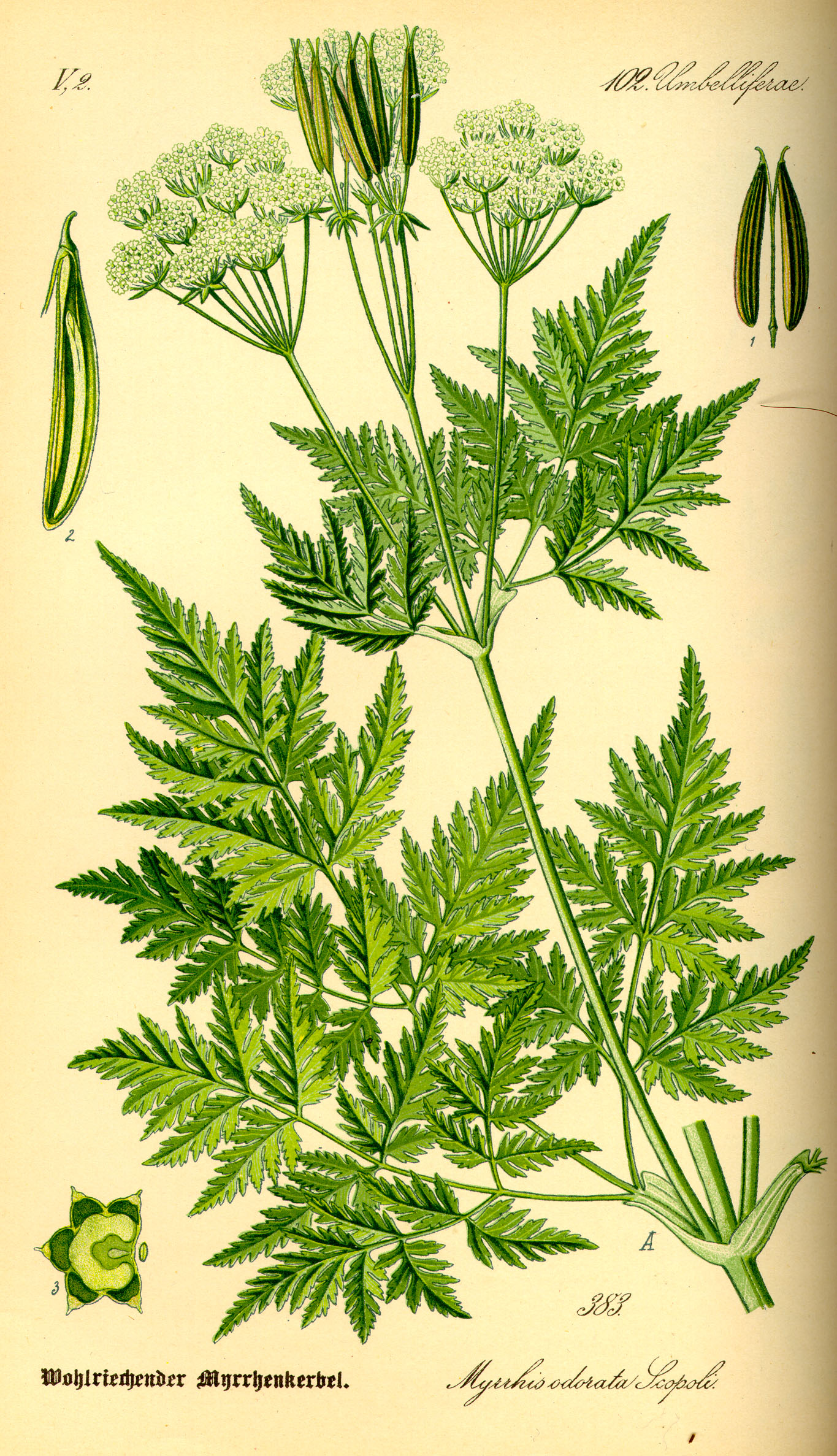|
Cecily Jordan Farrar
Cecily Jordan Farrar was one of the earlier women settlers of colonial Jamestown, Virginia. She arrived in the colony as a child in 1610 and was established as one of the few female ancient planters by 1620. After her husband Samuel Jordan died in 1623, Cecily obtained oversight of his 450-acre plantation, Jordan's Journey. In the Jamestown Muster of 1624-1625, she is one of fewer than 10 women who are mentioned as a head of household, and the only woman listed as sharing the head of household with a man she was not married to. In the year of Samuel Jordan's death, she set off the first breach of promise lawsuit in English North America when she chose the marriage proposal of William Farrar, who was bonded to help settle her estate, over that of Greville Pooley, who claimed his proposal had already been accepted. In 1625, Cecily prevailed when Pooley withdrew his claim. Afterward, she married William Farrar. The early years in the Virginia Colony Nothing is known of Cecil ... [...More Info...] [...Related Items...] OR: [Wikipedia] [Google] [Baidu] |
Colony Of Virginia
The Colony of Virginia, chartered in 1606 and settled in 1607, was the first enduring English colonial empire, English colony in North America, following failed attempts at settlement on Newfoundland (island), Newfoundland by Sir Humphrey GilbertGilbert (Saunders Family), Sir Humphrey" (history), ''Dictionary of Canadian Biography'' Online, University of Toronto, May 2, 2005 in 1583 and the colony of Roanoke (further south, in modern eastern North Carolina) by Sir Walter Raleigh in the late 1580s. The founder of the new colony was the Virginia Company, with the first two settlements in Jamestown, Virginia, Jamestown on the north bank of the James River and Popham Colony on the Kennebec River in modern-day Maine, both in 1607. The Popham colony quickly failed due to Starving Time, a famine, disease, and conflicts with local Native American tribes in the first two years. Jamestown occupied land belonging to the Powhatan Confederacy, and was also at the brink of failure before the arr ... [...More Info...] [...Related Items...] OR: [Wikipedia] [Google] [Baidu] |
London Company
The London Company, officially known as the Virginia Company of London, was a division of the Virginia Company with responsibility for colonizing the east coast of North America between latitudes 34° and 41° N. History Origins The territory granted to the London Company included the eastern coast of North America from the 34th parallel ( Cape Fear) north to the 41st parallel (in Long Island Sound). As part of the Virginia Company and Colony, the London Company owned a large portion of Atlantic and inland Canada. The company was permitted by its charter to establish a settlement within this area. The portion of the company's territory north of the 38th parallel was shared with the Plymouth Company, with the stipulation that neither company found a colony within 100 miles (161 km) of the other. The London Company made landfall on 26 April 1607, at the southern edge of the mouth of the Chesapeake Bay, which they named Cape Henry, near present-day Virginia Beach. Decid ... [...More Info...] [...Related Items...] OR: [Wikipedia] [Google] [Baidu] |
Colonial American Women
Colonial or The Colonial may refer to: * Colonial, of, relating to, or characteristic of a colony or colony (biology) Architecture * American colonial architecture * French Colonial * Spanish Colonial architecture Automobiles * Colonial (1920 automobile), the first American automobile with four-wheel brakes * Colonial (Shaw automobile), a rebranded Shaw sold from 1921 until 1922 * Colonial (1921 automobile), a car from Boston which was sold from 1921 until 1922 Places * The Colonial (Indianapolis, Indiana) * The Colonial (Mansfield, Ohio), a National Register of Historic Places listing in Richland County, Ohio * Ciudad Colonial (Santo Domingo), a historic central neighborhood of Santo Domingo * Colonial Country Club (Memphis), a golf course in Tennessee * Colonial Country Club (Fort Worth), a golf course in Texas ** Fort Worth Invitational or The Colonial, a PGA golf tournament Trains * ''Colonial'' (PRR train), a Pennsylvania Railroad run between Washington, DC and New Yor ... [...More Info...] [...Related Items...] OR: [Wikipedia] [Google] [Baidu] |
Close Roll
The Close Rolls () are an administrative record created in medieval England, Wales, Ireland and the Channel Islands by the royal chancery, in order to preserve a central record of all letters close issued by the chancery in the name of the Crown. History The first surviving Close Roll was started in 1204 (in the reign of King John), under the Chancellorship of Hubert Walter, though the actual practice may reach back to 1200, or even before.Sayles, G. O. ''The Medieval Foundations of England'' (London 1967) p. 291 Copies of the texts of the letters were written on sheets of parchment, which were stitched together into long rolls to form a roll for each year. Nature of contents Copies of royal grants of land or money (further transcribed to the Exchequer) made up the earliest contents of the Close Rolls; but the latter soon came to contain much wider matter, exchequer-related material being hived off after 1226 in separate Liberate Rolls. Indeed, in the early 13th century perh ... [...More Info...] [...Related Items...] OR: [Wikipedia] [Google] [Baidu] |
Public Record Office
The Public Record Office (abbreviated as PRO, pronounced as three letters and referred to as ''the'' PRO), Chancery Lane in the City of London, was the guardian of the national archives of the United Kingdom from 1838 until 2003, when it was merged with the Historical Manuscripts Commission to form The National Archives, based in Kew. It was under the control of the Master of the Rolls, a senior judge. The Public Record Office still exists as a legal entity, as the enabling legislation has not been modified. History 19th century The Public Record Office was established in 1838, to reform the keeping of government and court records which were being held, sometimes in poor conditions, in a variety of places. Some of these were court or departmental archives (established for several centuries) which were well-run and had good or adequate catalogues; others were little more than store-rooms. Many of the professional staff of these individual archives simply continued their existi ... [...More Info...] [...Related Items...] OR: [Wikipedia] [Google] [Baidu] |
Bailey's Creek 1
Baileys Irish Cream is an Irish cream liqueur, an alcoholic drink flavoured with cream, cocoa and Irish whiskey. It is made by Diageo at Nangor Road, in Dublin, Ireland and in Mallusk, Northern Ireland. It is the original Irish cream, invented by a team headed by Tom Jago in 1971 for Gilbeys of Ireland; Diageo currently owns the trademark. It has a declared alcohol content of 17% by volume. History and origin Baileys Irish Cream was created by Tom Jago of Gilbeys of Ireland, a division of International Distillers & Vintners, as Gilbeys searched for something to introduce to the international market. The process of finding a product began in 1971, and production research began in earnest after consultants David Gluckman, Hugh Seymour-Davies and Mac Macpherson came up with an alcoholic drink made of Irish whiskey and cream that, they remarked, "didn't taste punishing". The formulation of Baileys was motivated partly by the availability of alcohol from a money-los ... [...More Info...] [...Related Items...] OR: [Wikipedia] [Google] [Baidu] |
Virginia Governor's Council
The Governor's Council (also known as the "Council of State" or simply "the Council") was the upper house of the colonial legislature (the House of Burgesses was the other house) in the Colony of Virginia from 1607 until the American Revolution in 1776. Consisting of 12 men who, after the 1630s were appointed by the British Sovereign, the Governor's Council also served as an advisory body to the Virginia Royal Governor and as the highest judicial body in the colony. Organization The Council consisted of no more than 12 men who served lifetime appointments to advise the governor and were, together with the governor, the highest court in the colony. Thus this body served as a legislative, executive, and judicial body. Modeled after the British House of Lords, the Governor's Council went through a definite evolution as the Virginia colony grew. During much of the colonial period, the governor was absentee and the lieutenant governor was the beneficiary of the council's advice. When ... [...More Info...] [...Related Items...] OR: [Wikipedia] [Google] [Baidu] |
Cicely Embossed And Cropped
''Myrrhis odorata'', with common names cicely (), sweet cicely, myrrh, garden myrrh, and sweet chervil, is a herbaceous perennial plant belonging to the celery family Apiaceae. It is the only species in the genus ''Myrrhis''. Etymology The genus name ''Myrrhis'' derives from the Greek word myrrhis �υρρίς an aromatic oil from Asia. The Latin species name ''odorata'' means ''scented''.M. Grieve A Modern Herbal/ref> Description ''Myrrhis odorata'' is a tall herbaceous perennial plant growing to 2 m ft 6 intall, depending on circumstances. The leaves are fern-like, 2-4-pinnate, finely divided, feathery, up to 50 cm long, with whitish patches near the rachis. The plant is softly hairy and smells strongly of aniseed when crushed. The flowers are creamy-white, about 2–4 mm across, produced in large umbels. The flowering period extends from May to June. The fruits are slender, dark brown, 15–25 mm long and 3–4 mm broad. Distribution and ... [...More Info...] [...Related Items...] OR: [Wikipedia] [Google] [Baidu] |
Powhatan Attack Of 1622
The Indian massacre of 1622, popularly known as the Jamestown massacre, took place in the English Colony of Virginia, in what is now the United States, on 22 March 1622. John Smith, though he had not been in Virginia since 1609 and was not an eyewitness, related in his ''History of Virginia'' that warriors of the Powhatan "came unarmed into our houses with deer, turkeys, fish, fruits, and other provisions to sell us". The Powhatan then grabbed any tools or weapons available and killed all the English settlers they found, including men, women, children of all ages. Chief Opechancanough led the Powhatan Confederacy in a coordinated series of surprise attacks, and they killed a total of 347 people, a quarter of the population of the Virginia colony. Jamestown, founded in 1607, was the site of the first successful English settlement in North America, and was the capital of the Colony of Virginia. Its tobacco economy, which quickly degraded the land and required new land, led to c ... [...More Info...] [...Related Items...] OR: [Wikipedia] [Google] [Baidu] |
James River
The James River is a river in the U.S. state of Virginia that begins in the Appalachian Mountains and flows U.S. Geological Survey. National Hydrography Dataset high-resolution flowline dataThe National Map , accessed April 1, 2011 to Chesapeake Bay. The river length extends to if one includes the Jackson River, the longer of its two source tributaries. It is the longest river in Virginia. Jamestown and Williamsburg, Virginia's first colonial capitals, and Richmond, Virginia's current capital, lie on the James River. History The Native Americans who populated the area east of the Fall Line in the late 16th and early 17th centuries called the James River the Powhatan River, named for the chief of the Powhatan Confederacy which extended over most of the Tidewater region of Virginia. The Jamestown colonists who arrived in 1607 named it "James" after King James I of England (), as they constructed the first permanent English settlement in the Americas at Jamestown along t ... [...More Info...] [...Related Items...] OR: [Wikipedia] [Google] [Baidu] |
Alexander Brown (author)
Alexander "Sandy" Brown (September 5, 1843 – August 19, 1906) was a Confederate soldier and American merchant, best known as the author of several books on the early history of Virginia. Early and family life He was born at Glenmore in Nelson County, Virginia to Sarah Cabell Callaway Brown (1820-1849) and her husband Robert Lawrence Brown (1820-1880), the eldest of their three children, but his brother and sister died as infants. His paternal grandfather, also named Alexander Brown (1796-1864), was born near Perth, Scotland, came to Virginia in 1811, studied at the College of William & Mary, then worked for his merchant uncle at Lovingston in Nelson County. After taking over that business, with prominent planter Robert Rives as his partner, he married Rives' daughter Lucy Shands Rives, won several elections to represent Nelson County in the Virginia House of Delegates, served many years as the chief judge in Nelson County, and rose to the rank of General in the local militi ... [...More Info...] [...Related Items...] OR: [Wikipedia] [Google] [Baidu] |







